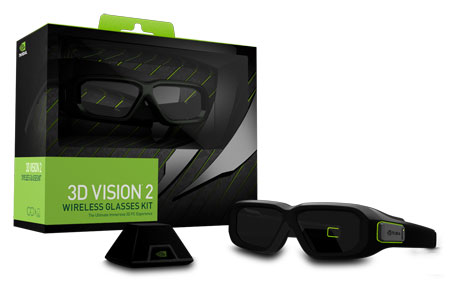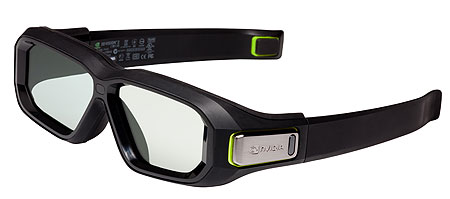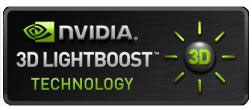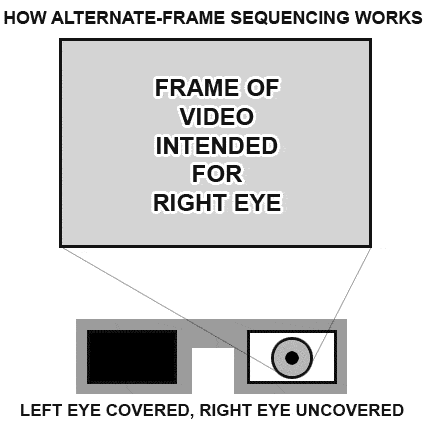Stereo Shoot-Out: Nvidia's New 3D Vision 2 Vs. AMD's HD3D
Nvidia just updated its stereoscopic 3D ecosystem with 3D Vision 2. We show you what makes this initiative different and how it compares to the competition. Then, we benchmark GeForce and Radeon graphics cards in a no-holds-barred stereo showdown!
3D Vision Gets Updated
At the very end of September, we published Nvidia 3D Vision Vs. AMD HD3D: 18 Games, Evaluated, an article that focused on the image quality of two competing stereoscopic 3D solutions in a variety of games. At the time, we were unable to compare frame rate performance because we didn't have all the necessary test equipment; now that the requisite gear is here, we’re able to complete our analysis and deliver a clear comparison between these standards.
On top of that, Nvidia just launched 3D Vision 2, which is an update to its more than two-and-a-half-year-old proprietary stereoscopic 3D ecosystem. So, before we do anything else, let’s have a close look at what’s new.

3D Vision 2
3D Vision 2 doesn’t mess with the fundamentals of Nvidia's technology; it works the same way it always has. Rather, it's composed of several hardware updates designed to improve the experience. The new standard is backwards-compatible, and that means you can use 3D Vision 2 glasses with a monitor based on the previous standard and vice versa. With over half a million of the original 3D Vision displays and notebooks in the hands of consumers, compatibility is a very good thing. Frankly, some television manufacturers could learn a thing or two from Nvidia's approach.
So, what did the company update, exactly? 3D Vision 2 sets a higher standard for display and glasses hardware. Let’s take a closer look at the glasses, first.

3D Vision 2 glasses have a 20% larger aperture than their predecessors, which allows for a larger viewing area and better peripheral vision. At the same time, interfering ambient light is blocked with a shield surrounding the rim. It's constructed of materials that are more flexible than the original, improving comfort and suggesting that the new model should be able to handle more stress. The arms are wider, and we find that they provide a more secure fit. Nvidia suggests that the new glasses accommodate headphones more comfortably, too. And while we were skeptical of this claim we found it to be true: the new, thinner arms sit closer to the head and afford more space for audio equipment.

Are these glasses a game-changer? Not really. But it’s safe to say that they are superior. The best news is that they’re cheaper than the originals. 3D Vision wireless glasses sold at a $150 MSRP, while the new glasses are priced at $99. That’s the same as the old wired glasses, so the situation is win-win for enthusiasts.
Get Tom's Hardware's best news and in-depth reviews, straight to your inbox.

The main improvement tied to 3D Vision 2 is part of the display, and it’s called Nvidia 3D LightBoost. Our biggest complaint about 3D Vision is that it's very dark, forcing you to really keep ambient light under control for the best experience. Then, not only is the display difficult to see, but the glasses cut out so much light that it’s difficult to see peripherals like your keyboard in stereoscopic 3D mode. LightBoost addresses both issues with a brighter monitor backlight combined with optimized shutter timings.
Instead of outputting a constant level of brightness, the 3D Vision 2 LED backlight pulses twice as brightly. That's self explanatory, but the timing issue is a little trickier to describe. Stereoscopic 3D requires that each eye sees a separate vantage point, and the method 3D Vision uses to achieve this is called alternate-frame sequencing; it's the same method that most modern 120 Hz 3DTV's with battery-powered shutter glasses employ.
It works like this: the television displays a frame of video for the left eye, then a frame of video for the right eye, alternating back and forth. this happens at 120 Hz, or 120 times per second (so fast that, to the naked eye, it just looks like there's a blurry double image). That's where the shutter glasses come in. The glasses cover the left eye when the video for the right eye is displayed, and vice versa, alternating back and forth so quickly that you can't perceive that your eye is being covered and uncovered.
The diagram below shows how this works, but in slow motion:

During this process, there’s some overlap time between frames of video where both eyes are covered at the same time. This prevents ghosting by giving the monitor time to refresh over the previous frame. 3D Vision 2 exploits the better performance inherent to today’s monitors, allowing the shutters to remain open for longer, meaning your eyes have more time to collect light. Everything appears brighter, and that applies both to what’s on the screen and in your environment.
This makes a huge difference in practice. Now, we're able to read the keys on our keyboard when using 3D Vision 2 (something that was quite difficult with its predecessor). Moreover, backwards compatibility works like a charm; the older 3D Vision glasses enjoy the same benefit from the tighter timings on new displays with LightBoost.
We’re testing an Asus VG278H in this piece, a 27” model with a built-in 3D Vision 2 emitter and a bundled pair of new glasses. Nvidia also lists the Acer HN274HB and BenQ XL2420T/XL2420TX as 3D Vision 2-certified monitors you should expect to see in the near future. On the laptop front, Toshiba plans to offer the Qosmio X770/X775 and Satellite P770/775 with 17.3” 1080p screens incorporating LightBoost technology.
Now that we know how 3D Vision 2 compares to the original, let’s see how it compares to the competition!
Current page: 3D Vision Gets Updated
Next Page Nvidia 3D Vision 2 Vs. AMD HD3D: Comparing HardwareDon Woligroski was a former senior hardware editor for Tom's Hardware. He has covered a wide range of PC hardware topics, including CPUs, GPUs, system building, and emerging technologies.
-
airborne11b I didn't see any mention of crosstalk *3D GHOSTING* in this article.Reply
Does this new nvidia vision 2 really reduce crosstalk? He'll it's even listed on the promotion of the product
http://media.bestofmicro.com/7/X/311325/original/Third%20Generation%203D%20Monitors.JPG
Yet I saw no mention of it in this article. Any word on how well it handles cross talking / 3D ghosting would be appreciated. -
de5_Roy the glasses look kinda dorky.. still waiting for glasses-free 3d. i'd rather use a 120 hz monitor instead of eye-hurting 60 hz ones (without 3d).Reply -
bystander It would appear that virtual 3D mode takes a lot less power to render a single image and extrapolate the other eyes image than it is to render two images independently in normal mode. This appears to be the only reason it does compete without crossfire support. This is both good and bad. It works in almost all situations, but never at great visual quality.Reply
I'd also like to point out that the lack of AA is not a big deal in 3D. I find I don't notice the same issues without AA in 3D. When the mind fuses two images together, it's not as bothered by AA. -
airborne11b greghomeIMO, 3D is still not as appealing and no as cheap as Eyefinity or 2D Vision Tri-Screen Gaming.Reply
I'm a fan of both 3x monitor set ups, but 3D is a lot cooler.
Problem with 3x monitors is the fish-eye effect that's very disturbing (and not fixable) in landscape mode. The best you can do with 3x monitors is use expensive 1920 x 1200 IPS monitors in portrait mode, but in this set up the bezels are normally cutting right through game HUDs / hotkey bars and puts the bezels far too close to your center of view.
Further more, for this kind of Eyefinity/Nvidia surround monitor set up, costs about $1200 - $1500. (Or even more expensive projector set ups that require a ton of space and cost as much or more if you want to try and get rid of the bezels)
Now consider Nvidia 3D. It adds amazing depth and realism to the games over 2D, doesn't have a negitive "fish eye effect", no bezels to deal with, same GPU power requirements as 3x monitors (or less), doesn't interrupt game huds or hotbars and only costs about $600-700 for the most expensive 27" screen + glasses combos. (even cheaper with smaller monitors.
The clear choice is 3D imo.
But 3x monitors is still much better then single 2D monitor. I rocked 5760 x 1080 in BFBC2, Aion and L4D for a long time :P.
3D is cooler though. -
billcat479 It seems people don't follow the news on this area very much. It's not sounding all that great.Reply
I guess most people haven't read that people using 3D tv's have been getting headaches and it's not a few but a lot of people.
They should have left it in the theaters.
I wouldn't be surprised to find if and when they do a good long term study of people using them long term in gaming start to have long term medical problems if or when they get around to doing good studies on the topic. I have read enough to stay away from this 3D glasses hardware. At best I'd only use it very little and for short term use.
They really do need to do medical testing on this because people are being effected by prolonged use of 3D glasses with tv. Add all day video gaming and I think there is a possibility small or large of long term or perm. damage to people. They dumped this on the market pretty fast without doing any studies that I know of but with the amount of people showing headaches I think it is getting more attention or should damm well start checking out the possibility of any chance of eye damage or worse.
Eyesight is pretty useful.
If they ever get a holographic display then I'd be into it.
-
amk-aka-Phantom Dirt 3, first benchmark: 6790 and 6970 should switch places! Right now 6790 is performing 5 times as good as the 6970 :D Fix that, please.Reply -
CaedenV @billcatReply
So shutter tech which has been around some 15 years is dangerous, but holographic tech which isn't really available yet would be good? I would think you would want to exercise caution with any new optical tech. Personally I am allergic to the laser-to-eye theory of hologram tech.
As for the article, it was a great review! Looks like the tech is still too high end for my budget, but I am sure they will iron out all the kinks by the time I am ready to replace my monitor (which wont be soon as I love the thing). I am really curious about how the next gen graphics cards will improve in this area! Cant wait for those reviews! -
airborne11b billcat479It seems people don't follow the news on this area very much. It's not sounding all that great. I guess most people haven't read that people using 3D tv's have been getting headaches and it's not a few but a lot of people. They should have left it in the theaters. I wouldn't be surprised to find if and when they do a good long term study of people using them long term in gaming start to have long term medical problems if or when they get around to doing good studies on the topic. I have read enough to stay away from this 3D glasses hardware. At best I'd only use it very little and for short term use. They really do need to do medical testing on this because people are being effected by prolonged use of 3D glasses with tv. Add all day video gaming and I think there is a possibility small or large of long term or perm. damage to people. They dumped this on the market pretty fast without doing any studies that I know of but with the amount of people showing headaches I think it is getting more attention or should damm well start checking out the possibility of any chance of eye damage or worse. Eyesight is pretty useful. If they ever get a holographic display then I'd be into it.Reply
This is the kind of uninformed, ignorant posts that irritate me. Interweb wanna be docs who don't know how the human body works. Allow me to educate you.
People used to say that "reading a book in the dark" or watching TV or normal PC monitor "too close" would "damage your eyes". In fact we know today that eye sight degeneration has a few factors, none of which are from normal straining.
The most common cause of eye sight degeneration is Presbyopia (from the normal aging process, where the lens progressively loses its capacity to increase its power for near vision)
Also, UV rays degenerate tissue so it's recommended you way UV protective sunglasses when outside in daylight. UV rays can cause your eyesight to weaken over time.
Also refractive error(Common in people ALL ages): A condition may be either because the eye is too short or long in length, or because the cornea or lens does not have the required refractive power. There are three types of refractive errors which are Myopia (near-sight), Hypermetropia (long-sight) and Astigmatism which is the condition where the eye does not focus the light evenly, usually due to the cornea of the eye being more curved in one direction than the other. It may occur on its own or may be associated with myopia or hypermetropia.
The very worst thing that 3D vision can do in terms of negitive health effects, is the same EXACT effects of reading too much, IE; an extremely short term headache. To cure the headache TAKE A BREAK.
Also, as you build tolerance to 3D vision (As I have just after a week or 2 of consistent use) the headaches go away. Also Nvidia 3D settings allow you to adjust the depth of the 3D, less depth = less strain and you can progressively increase 3D as you build tolerance to the use of 3D monitors.
In closing, don't post nonsense about what you don't understand. It makes you look stupid. -
oneseraph I normally don't chime in however in this case I just have to say "Who Cares"? Every time I see an article about 3D graphics and 3D display tech there are always excuses for the technology not being ready. Did I misunderstand or did this article point out that neither Nvidia or AMD have a ready for prime time product. So why are they releasing this crap to us consumers and calling it a feature? When the truth is it Tech that still belongs in the lab. Come on, if you bought a blender that would blend strawberries but would not work if you put bananas in it you not only return the item but in all likelihood there would be a class action suite against the manufacturer. In short for right now 3D is just not ready. The marketing departments of both Nvidia and AMD are being more than a little dishonest about they're respective 3D features. There are lots of good reasons to buy a new graphics card. Just don't be fooled into thinking that 3D is one of them.Reply